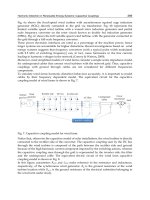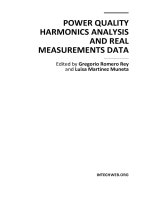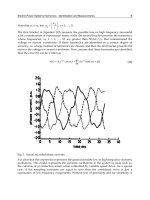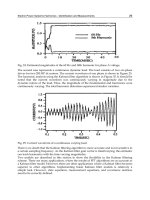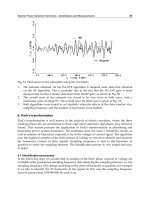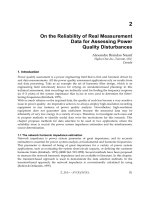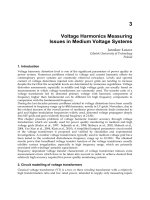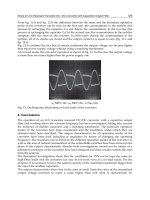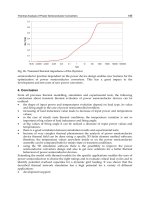Power Quality Harmonics Analysis and Real Measurements Data Part 9 pptx
Bạn đang xem bản rút gọn của tài liệu. Xem và tải ngay bản đầy đủ của tài liệu tại đây (2.6 MB, 20 trang )
Thermal Analysis of Power Semiconductor Converters
149
0
0,1
0,2
0,3
0,4
0,5
0,6
0,7
1E-06 0,00001 0,0001 0,001 0,01 0,1 1 10 100 1000 10000 100000 1000000
t [s]
Zth [°C/W]
Fig. 26. Transient thermal impedance of the thyristor
semiconductor junction dependent on the power device design enables new features for the
optimization of power semiconductor converters. This has a great impact to the
development and test costs of new power converters.
4. Conclusion
From all previous thermal modelling, simulation and experimental tests, the following
conclusions about transient thermal evolution of power semiconductor devices can be
outlined:
the shape of input power and temperatures evolution depend on load type, its value
and firing angle in the case of power semicontrolled rectifiers;
increasing of load inductance value leads to decrease of input power and temperature
values;
in the case of steady state thermal conditions, the temperature variation is not so
important at big values of load inductance and firing angle;
at big values of firing angle it can be noticed a decrease of input power values and
temperatures;
there is a good correlation between simulation results and experimental tests;
because of very complex thermal phenomenon the analysis of power semiconductor
device thermal field can be done using a specific 3D finite element method software;
therefore, the temperature values anywhere inside or on the power semiconductor
assembly can be computed both for steady-state or transient conditions;
using the 3D simulation software there is the possibility to improve the power
semiconductor converters design and also to get new solutions for a better thermal
behaviour of power semiconductor devices.
Extending the model with thermal models for the specific applications enables the user of
power semiconductors to choose the right ratings and to evaluate critical load cycles and to
identify potential overload capacities for a dynamic grid loading. It was shown that the
described thermal network simulation has a high potential for a variety of different
applications:
development support;
Power Quality Harmonics Analysis and Real Measurements Data
150
identifying user risks;
evaluating the right rated current;
evaluating overload capacity without destructive failure of the power semiconductor.
5. References
Allard, B., Garrab, H. & Morel, H. (2005). Electro-thermal simulation including a
temperature distribution inside power semiconductor devices,
International Journal
of Electronics, vol.92, pp. 189-213, ISSN 0020-7217
Chester, J. & Shammas, N. (1993). Thermal and electrical modelling of high power
semiconductor devices,
IEE Colloquium on Thermal Management in Power Electronics
Systems
, pp. 3/1 - 3/7, London, UK
Chung, Y. (1999). Transient thermal simulation of power devices with Cu layer,
Proc. 11th
International Symposium on Power Semiconductor Devices and ICs. ISPSD'99, pp. 257-
260, ISBN 0-7803-5290-4
Deskur, J. & Pilacinski, J. (2005). Modelling of the power electronic converters using
functional models of power semiconductor devices in Pspice,
European Conference
on Power Electronics and Applications, ISBN 90-75815-09-3
Gatard, E., Sommet, R. & Quere, R. (2006). Nonlinear thermal reduced model for power
semiconductor devices,
Proc. 10th Intersociety Conference on Thermal and
Thermomechanical Phenomena in Electronics Systems, ISBN 0-7803-9524-7
Kraus, R. & Mattausch, H. (1998). Status and trends of power semiconductor device models
for circuit simulation.
IEEE Transactions on Power Electronics, vol.13, pp. 452 – 465,
ISSN 0885-8993
Kuzmin, V., Mnatsakanov, T., Rostovtsev, I. & Yurkov, S. (1993). Problems related to power
semiconductor device modelling,
Fifth European Conference on Power Electronics and
Applications, pp. 113 – 117, ISBN 0-8529-6587-7
Maxim, A., Andreu, D., & Boucher, J. (2000). A unified high accuracy SPICE library for the
power semiconductor devices built with the analog behavioral macromodeling
technique,
Proc. 12th Int. Symp. on Power Semiconductor Devices and Ics, pp. 189 – 192,
ISBN 0-7803-6269-1
Nelson, J., Venkataramanan, G. & El-Refaie, A. (2006). Fast thermal profiling of power
semiconductor devices using Fourier techniques,
IEEE Transactions on Industrial
Electronics, vol.53, pp. 521 – 529, ISSN 0278-0046
Pandya, K. & McDaniel, W. (2002). A simplified method of generating thermal models for
power MOSFETs,
Proc. Eighteenth Annual IEEE Semiconductor Thermal Measurement
and Management Symposium, ISBN 0-7803-7327-8
Schlogl, A., Mnatsakanov, T. & Schroder, D. (1998). Temperature dependent behaviour of
silicon power semiconductors-a new physical model validated by device-internal
probing between 400 K and 100 K,
Proc. of the 10th Int. Symp. on Power Semiconductor
Devices and ICs ISPSD, pp. 383 – 386, ISBN 0-7803-5100-2
Shammas, N., Rodriguez, M. & Masana, F. (2002). A simple evaluation method of the
transient thermal response of semiconductor packages,
Microelectronics Reliability,
vol.42, pp. 109-117, ISSN 0026-2714
Sunde, V., Jakopovic, Z. & Cobanov, N. (2006). Simple Hybrid Electrothermal Simulation
Procedure,
12th International Power Electronics and Motion Control Conference, pp. 617
– 620, ISBN 1-4244-0121-6
Wenthen, F. (1970). Computer-aided thermal analysis of power semiconductor devices.
IEEE Transactions on Electron Devices, vol.17, pp. 765 – 770, ISSN 0018-9383
Part 3
Harmonic Distortion
6
Improve Power Quality with
High Power UPQC
Qing Fu, Guilong Ma and Shuhua Chen
Sun Yat-sen University
China
1. Introduction
An ideal AC power transmission is pure sinusoidal, both its voltage and its current. With
the increasing production of modern industry, more and more power electronic equipments
are used and cause serious current distortion because of open and close of power electronic
devices. Harmonic, a measurement of distorted degree of voltage or current, reflects the
deviation from sinusoidal wave. Another cause of harmonic is nonlinear loads such as Arc
furnaces and transformers. The widely using of nonlinear load brings much harmonic
current to transmission lines. The harmonic current passes through transmission lines and
causes harmonic voltage exert on the loads in other place(Terciyanli et al. 2011). As a result,
the loss of power transmission is increased and the safety of power grid is seriously
weakened.
With the fast development of modern production, the harmonic in power grid become more
and more serious and people pay more attention to how to eliminate harmonic(wen et al.
2010). Active Power Filter (APF) is a promising tool to cut down the influence of harmonics,
shunt APF for harmonic current, series APF for harmonic voltage. Unified Power Quality
Conditioner (UPQC), consisted of shunt APF and series APF, is effective to reduce both
harmonic voltage and harmonic current. Now, UPQC is mainly used in low-voltage low-
capacity applications. But with the development of power system, more and more high-
power nonlinear loads are connected to higher voltage grid and the demand of high voltage
and high capacity keeps being enlarged. The paper discussed a high power UPQC for high
power nonlinear loads. In this UPQC, shunt APF uses a hybrid APF which includes a
Passive Power Filter (PPF) and an APF. Shunt APF is connected to a series LC resonance
circuit in grid fundamental frequency so as to make shunt APF in lower voltage and lower
power. The series LC resonance circuit is connected to grid with a capacitor. DC linker of
PPF is connected to DC link of APF. This type of UPQC is fit for high voltage high power
application because the voltage and capacity of its active device is much lower than those of
the whole UPQC. The paper discussed the principle and control method of this UPQC.
2. Fundamental knowledge
To show better about the principle and the theory about the high power UPQC, some
fundamental knowledge about harmonic and harmonic elimination equipments are list below.
Power Quality Harmonics Analysis and Real Measurements Data
154
2.1 Series active power filter
In power system, voltage out from turbine is promising to be sinusoidal. So if there is no
nonlinear load connects to power grid between generator and the nonlinear load in
question, a shunt APF is enough to keep both the voltage and the current of transmission
line sinusoidal because the transmission line is composed of linear components such as
resistances, inductions and capacitors. But in modern power system, power is transmitted
for a long distance before delivery to the nonlinear load and power is distributed to many
nonlinear loads in many difference places along the transmission line. The transmission of
harmonic current causes harmonic voltage in transmission lines which increases possibility
of damage to some critical loads such as storage devices and some micromachining devices.
Shunt APF can do little with the damage caused by harmonic voltage in transmission line. A
series APF is installed between power source and critical load so as to insulate voltage
harmonic from the critical load(Kim et al. 2004). It is also promising to eliminate damages to
load caused by some other supply quality issues such as voltage sage, instant voltage
interrupts, flicks and over voltage.
Z
s
C1
L1
Critical load
T
U
E
C1
+
-
+
-
C
+
-
2inv
U
E
C2
Fig. 1. Configuration of series APF
2.2 Shunt active power filter
The distortion of current not only brings serious loss of power transmission, but also
endangers power grid and power equipments. Harmonic current increases the current
flowed through transmission lines and as a result power transmission loss is increased and
power grid has to take a risk of higher temperature which threatens the safety of power
grid. Harmonic current in transformers will make them magnetic saturated and seriously
heated. Much noise is generated because of harmonics in equipments. Besides, harmonics
make some instruments indicate or display wrong values, and sometimes make they work
wrong.
To eliminate harmonic current produced by nonlinear loads, a shunt Active Power Filter
(APF) is expected to connect parallel to power grid(Ahmed et al. 2010). Shunt APF draws
energy from power grid and makes it to be harmonic current that is equal to the harmonic
current produced by nonlinear load so that harmonic current doesn’t go to transmission line
but goes between nonlinear load and APF. Usually an inverter is employed to realize this
function.
Improve Power Quality with High Power UPQC
155
Nonlinear
load
Inverter
APF
S
Z
Utility
Sh
i
Fh
i
Lh
i
Fig. 2. Configuration of shunt APF
Fig.2 shows Configuration of shunt APF, where
s
Z is impedance of transmission line,
sh
i is
harmonic current trough transmission line,
Lh
i is load harmonic current and
Fh
i is harmonic
current from APF. APF employs an inverter to generator a harmonic current that always
keeps equal to load harmonic current, that is:
LhFh
ii
(1)
Then load harmonic current is intercepted by APF and will not pass through transmission
line.
0
sh
i
(2)
Usually a voltage source inverter which uses a high capacity capacitor to store energy in DC
linker is used.
Under some conditions, nonlinear load not only produces harmonic current but also
produces much more reactive current. In order to avoid reactive current going to
transmission line, the shunt equipment needs to compensate also the reactive current.
Passive Power Filter (PPF) is usually added to APF to compensate most of reactive current
and a part of harmonic current so as to decrease the cost. This hybrid system of APF and PF
is called Hybrid Active Power Filter (HAPF) (Wu et al. 2007). In HAPF, APF and PPF are
connected in different forms and form many types of HAPF. Because of its low cost, HAPF
attracts more and more eyes and has been developing very quickly.
2.3 UPQC: Combined shunt APF and series APF
Unified Power Quality Conditioner (UPQC) is composed of series APF and shunt APF(Yang
& Ren, 2008). It not only protects the critical load from voltage quality problems but also
eliminates the harmonic current produced by load. In UPQC, the series APF (usually called
its series device) and shunt APF (usually called its shunt device) usually share the energy
storage so as to simplify the structure and reduce the cost of UPQC.
Power Quality Harmonics Analysis and Real Measurements Data
156
Load
UPQ
C
Inverter2
Inverter1
Utility
S
Z
Fig. 3. Unified Power Quality Conditioner
3. An UPQC in high power application
In many mid-voltage or high-voltage applications, nonlinear load not only produces heavy
harmonic current but also is sensitive to harmonic voltage. An UPQC combined a series APF
and a HAPF is much suitable for these applications(Khadkikar et al.,2005). Fig.4 shows the
detailed system configuration of the high power UPQC, where
sa
e
,
sb
e
and
sc
e
are three
phase voltages of generator,
ca
e
,
cb
e
and
cc
e
are the voltages compensated by series APF,
s
I
is utility current,
L
I
is load current,
F
I
is compensating current output from shunt device,
s
Z
is impedance of transmission line, C is a big capacitor for DC linker.
2
T
1
T
Fig. 4. Configuration of high power UPQC
The high power UPQC is composed of series device and shunt device. The series device is
mainly for insulating the source voltage interference, adjusting loads voltage etc. The shunt
device is mainly for eliminating harmonic current produced by nonlinear load. In series
device,
1
L and
1
C make low-pass filter (LPF) to filter output voltage of Inverter 2 because
power electronics devices in Inverter 2 open and close in high frequency and generate high
frequency disturbances exerted on expected sinusoidal output voltage of Inverter 2. In series
device, transformer
2
T not only insulates Inverter 2 from utility but also makes output
voltage of Inverter 2 (after LPF) satisfy maximum utility harmonic voltage. In shunt device,
0
L and
0
C make a LPF to filter output voltage of Inverter 1. The shunt device and series
device share the DC capacitor. The shunt device is consisted of an inverter and a PPF. PPF is
Improve Power Quality with High Power UPQC
157
consisted of 3 L-C resonance branches. One is consisted of
5
L and
5
C for 5th harmonic
current elimination, the other is consisted of
7
L and
7
C for 7th harmonic current
elimination, and the third is consisted of
3
L ,
31
C ,
32
C for 3rd harmonic current elimination.
The resonance frequency of
3
L and
32
C is set to be the same as the frequency of fundamental
component so that most of fundamental reactive current in this series resonance branch goes
through
3
L and
32
C and little goes through inverter through transformer
1
T . As a result
Inverter 1 suffers little fundamental voltage which helps to cut down its cost and improve
its safety. Transformer T1 connects Inverter 1 with the series fundamental resonant branch
3
L and
32
C to insulate them and fit the difference between maximum output voltage of
Inverter 1 and maximum voltage that L3 and
32
C needed to generate the maximum
compensating current. The 3rd, 5th, 7th harmonic currents can be eliminated by the 3 L-C
resonance branches, and Inverter 1 can also inject harmonic current into utility to give a fine
compensation to every order harmonic current except 3rd harmonic current.
3.1 Series device of high power UPQC
Series device of UPQC is mainly to filter utility voltage and adjust voltage exerted on load
so as to eliminate harmonic current produced by utility harmonic voltage and provide load
a good sinusoidal voltage(Brenna et al. 2009; Zhou et al. 2009).
Series device of high power UPQC has the same topology as series APF whose
Configuration is shown in Fig.1. Fig.1shows the single phase equivalent circuit of the series
device, where
s
Z is impedance of transmission line. The main circuit and control circuit of
the active part are in the dashed box.
From the sigle-pahse system, the voltage of the transformer can be expressed as
1
22
11
C
Cinv
LC
Z
EU
ZZ
(3)
Suppose
12CC
EnE , then the voltage of the Inverter 2 can be calculated as
11
22
1
11
1
()
LC
inv C
C
LC
TL
C
ZZ
UE
Z
ZZ
UU
nZ
(4)
The voltage of Inverter 2 can be written at another way as
2
()
inv V DC
UKUBs
(5)
Where
V
K
is amplitude ratio between
2inv
U
and
DC
U
,
()Bs
is phase shift between input
control signal and output voltage of Inverter 2.
DCCLT
DC
CL
C
VT
CTL
UKU
U
ZZ
Z
sBKnU
EUU
11
1
1
)(
(6)
Power Quality Harmonics Analysis and Real Measurements Data
158
Where
1
11
()
C
CL V
LC
Z
KnKBS
ZZ
(7)
To make load voltage sinusoidal, load voltage
L
U is usually sampled for control. Control
scheme for series device is:
L
U
CL
K
*
2inv
U
DC
U
CC
K
T
U
2inv
U
)(sK
UL
*
L
U
Fig. 5. Control scheme for series device of high power UPQC
Where AVR1 is automatic voltage regulator for
L
U control and AVR2 is for
C
U control.
DC
U
is voltage of DC-linker.
()
UC
KSis transform function of detecting circuit of
C
U which is
consisted of a proportion segment and a delay segment.
()
UL
KSis transform function of
detecting circuit of
L
U .
*
L
U
is reference voltage for load voltage
L
U , when a certain
harmonic component is concerned, it is set to zero. AVR1 is automatic voltage regulator for
L
U and it can be divided to 3 parts, one is harmonic extraction, another is PI adjustor and
the third is delay array. Control scheme of AVR1 is depicted in Fig.6. A selective harmonic
extraction is adopted to extract the main order harmonics. Abc_dq0 is described as equation
(8-10) for a certain k order harmonic and transformation dq0_abc is described as equation
(11-13). LPF is low pass filter that only let DC component pass through.
00 0
222
( sin( ) sin[ ( )] sin[ ( )]
333
da b c
UVkVk Vk
(8)
00 0
222
( cos( ) cos[ ( )] cos[ ( )]
333
qa b c
UVkVk Vk
(9)
0
1
()
3
abc
UVVV
(10)
000
sin( ) cos( )
ad q
VU k U k U
(11)
000
22
sin[ ( )] cos[ ( )]
33
bd q
VUkUkU
(12)
Improve Power Quality with High Power UPQC
159
000
22
sin[ ( )] cos[ ( )]
33
cd q
VU k U k U
(13)
abc_dq
0
Le
U
abc_dq
0
d
q
0
d
q
0
M atrix for
phase
adjusting
PI
PI
dq0_ab
c
0
M atrix for
phase
adjusting
PI
PI
dq0_ab
c
0
LPF
abc_dq
0
d
q
0
M atrix for
phase
adjusting
PI
PI
dq0_ab
c
0
+
+
+
PWM
Fig. 6. Control scheme of AVR1
Because a delay will unavoidably happen during detecting and controlling, a matrix is used
to adjust the phase shift of the certain order harmonic. The matrix is described as:
q
d
q
d
U
U
kk
kk
U
U
)cos()sin(
)sin()cos(
00
00
'
'
(14)
Where
is phase angle for delay.
To check the effect of series device of high power UPQC to harmonic voltage, with
MATLAB, a 3-phase 10KV utility supplied to capacitors is set up. Suppose the initial load is
a 3-phase capacitor group, a resister valued 0.2 ohm series with a capacitor valued 100uF in
each phase. When t=0.04s, series device switches to run. Tab.1 shows the parameters of
power source and series device. Comparing the main harmonic voltages and harmonic
currents after series run with those before series run, we know that series device reduce
much harmonic of load voltage and so load harmonic current is much reduced. Fig.7 shows
waveform of load voltage before and after series device run. In Fig.8, the spectrums of load
voltage are compared through FFT. Fig.9 shows load current waveform and Fig.11 shows
the spectrums of load current before and after series device run. With transformer T
2
,
fundamental voltage produced by Inverter 2 can be added to power source, so it can also
compensate voltage sags. When it is concerned,
*
L
U in Fig.6 is set to be expected fundament
component of source voltage. Fig.12 and Fig.13 shows this function of series device. At 0.1s,
utility voltage suddenly goes below to be 80 percents of previous voltage, as is shown in
Fig.12. If series device keep running before voltage sag happen, utility voltage will keep
almost const, as is shown in Fig.13.
Power Quality Harmonics Analysis and Real Measurements Data
160
Items Parameters
Utility fundamental
voltage
3-phase in positive sequence; line to line voltage:
10KV; Initial phase: 0 deg.
Utility 2nd harmonic
voltage
3-phase in negative sequence; line to line voltage:
250V; Initial phase: 0 deg.
Utility 3rd harmonic
voltage
3-phase in zero sequence; line to line voltage: 600V;
Initial phase: 0 deg.
Utility 5th harmonic
voltage
3-phase in negative sequence; line to line voltage:
1500V; Initial phase: 0 deg.
Utility 7th harmonic
voltage
3-phase in positive sequence; line to line voltage:
1300V; Initial phase: 0 deg.
Impedance of
transmission line
Resister: 0.04 ohm; Inductor : 1uH;
Low Pass filter L
1
: 4mH; C
1
: 15uF
Transformer T2 n=10
Load
3-phase series resister and capacitor
Resister: 0.2 ohm; capacitor: 100uF
Table 1. Parameters for series device
2nd (%) 3rd (%) 5th (%) 7th (%) THD(%)
Voltage before run 3.07 7.35 12.24 9.79 17.58
Voltage after run 0.88 1.55 3.55 2.37 4.66
current before run 6.09 21.93 60.48 66.96 93.05
current after run 1.99 4.86 17.72 16.44 25.67
Table 2. Harmonics before and after series device run
Fig. 7. Waveform of load voltage
Improve Power Quality with High Power UPQC
161
(a) Before series device run (b) After series device run
Fig. 8. FFT analysis for load voltage
Fig. 9. Waveform of load current
(a) Before series device run (b) After series device run
Fig. 10. FFT analysis for load current
Power Quality Harmonics Analysis and Real Measurements Data
162
Fig. 11. Voltage sag at 0.1s
Fig. 12. Load voltage when series device run
3.2 Shunt device of high power UPQC
Fig.13 shows the single phase equivalent circuit of the shunt device of high power UPQC.
The active part of the shunt device could be considered as an ideal controlled voltage source
U
inv1
, the Load harmonic source is equivalent to a current source I
L
. The impedance of the
output filter L
0
and C
0
are Z
L0
and Z
C0
.
Z
s
I
s
+
-
+
-
I
L
U
L
I
F
C
31
C
32
L
3
L
0
C
0
+
-
L
5
L
7
C
5
C
7
es
+
e
c1
1inv
U
+
-
+
-
PT
U
1
ST
U
1
1
T
PT
I
1
Fig. 13. The single phase equivalent circuit of the shunt device of UPQC
Suppose
1
1
1
TS
TP
U
n
U
and transformer
1
T
is a ideal transformer, we can learn
PTL
C
L
PT
C
PT
PTLPTinv
IZ
Z
Z
U
Z
U
IZUU
10
0
0
1
0
1
1011
)1(
)(
(15)
Improve Power Quality with High Power UPQC
163
And
)(
332
11
57
11
Z
Un
Z
U
InI
PTL
FPT
(16)
Where
5577
57
5577
()()
LCLC
LCLC
ZZZZ
Z
ZZZZ
, (17)
323332 CL
ZZZ
(18)
Besides
111 31
57
()
L
LTPF C
U
UnU I Z
Z
(19)
So
57 31 31
1
157 1
CC
TP L F
ZZ Z
UUI
nZ n
(20)
From equation (16) and (20), we get
L
C
F
C
PT
U
ZZn
ZZ
n
Z
nI
Z
Z
I )
1
()1(
332571
3157
1
57
1
332
31
1
(21)
Where
7755
7755
57
))((
LCLC
LCLC
ZZZZ
ZZZZ
Z
(22)
332332 LC
ZZZ
(23)
For completely compensating load harmonic current, I
F
is controlled to be the same as I
L
, so
31 57 31
111
332 57 1 57 332
1
(1 ) ( )
CC
TP L L
ZZZ
IInnU
ZZnZZ
(24)
From equation (24), we can find control rule for shunt device of UPQC. If Inverter 1 is
controlled to work as a current source, we can make it linear to load harmonic current and a
fore-feed controller of load harmonic voltage is expected to add to the harmonic current
controller. Control scheme for shunt device of high power UPQC is shown in Fig.14. To
support DC linker voltage, shunt device should absorb enough energy from utility. Because
it is easier for shunt device to absorb energy from utility, the DC linker voltage controller is
placed in control scheme of shunt device. A PI conditioner is used here to adjust
fundamental active current so as to keep DC-linker voltage const. ACR1 and ACR2 are the
same as that of series device. Current out of active part is detected and form a close-loop
controller. ACR3 is a hysteresis controller which makes Inverter 1 work as a current source.
U
L
is also added to control scheme as a fore-feed controller.
Fig.15 shows the effect of this control scheme for shunt device of UPQC. The simulation
parameters are shown in Tab.3. Suppose at 0.04s, passive part of shunt device is switched on
Power Quality Harmonics Analysis and Real Measurements Data
164
and at 0.1s active part is started. Fig.15 shows waveform of utility current during shunt device
is switched on. Fig.16 shows spectrums of utility current. Before shunt device switched on,
THD of utility current is 28.53%. after passive part is switched on, it is cut down to be 18.25%
and after active part is also switched on it is further cut down to be 11.97%.
DC
U
*
DC
U
2/3
3/2
IF
Z/1
IFIL
ZK /
F
I
L
U
1inv
U
L
I
)(
1
SK
inv
)(SK
IF
Fig. 14. Control scheme for shunt device of UPQC
Items Description
Power source 3-phase; line to line voltage:10KV;
Impedance of transmission
line
Resister: 0.04 ohm; Inductor : 1uH;
Load
Rectifier with series reactor and resister;
Reactor: 1mH; resister: 10 ohm;
Shunt device of UPQC
3rd
mHL 15
3
FC
334
31
FC
669
32
5th
mHL 4.3
5
FC
120
5
7th
mHL 5.1
7
FC
140
7
1
T
1
0
1
n
LPF
m
H
L 4
0
u
F
C 15
0
Table 3. Parameters for shunt device
Fig. 15. Utility current waveform
Improve Power Quality with High Power UPQC
165
(a) Before shunt device run (b) After PPF switched on (c) After APF switched on
Fig. 16. Spectrums of utility current
3.3 Entire control of high power UPQC
High power UPQC is composed of series device and shunt device. Its control scheme
combined control of series device and shunt device, as is shown in Fig.17. From above
discussion, we know that load harmonic current is a bad disturb to series device controller
because it influences load harmonic voltage. With shunt device, utility harmonic current is cut
down and it does help to series device controller. On the other hand, load harmonic voltage is
also a bad disturb to shunt device controller which will produce additional harmonic current
and influence effect of shunt device. With series device, load harmonic voltage is cut down
and it does help to shunt device controller. Cycling like this, effects of shunt device and series
device are both improved. Tab.4 shows parameters for high power UPQC.
DC
U
*
DC
U
2/3
3/2
IF
Z/1
IFIL
ZK /
F
I
L
U
1inv
U
L
I
L
U
CL
K
*
C
U
DC
U
CC
K
T
U
2inv
U
)( sK
UC
)(sK
UL
)(
1
SK
inv
)(SK
IF
Fig. 17. Control scheme for high power UPQC
Power Quality Harmonics Analysis and Real Measurements Data
166
Items Description
Power source
3-phase; line to line voltage:10KV;
2nd, 3rd, 5th, 7th harmonic voltage listed in Tab.1
Impedance of
transmission line
Resister: 0.04 ohm; Inductor : 1uH;
Load
Rectifier load in Tab.3 paralleled with 3-phase series resister
and capacitor listed in Tab.1
Shunt device Same as Tab.3
Series device Same as Tab.1
Table 4. Parameters for high power UPQC.
Suppose at 0.04s, series device is switched on, at 0.1s passive part of shunt device is
switched on and finally at 0.16s active part of shunt device is also switched on. Fig.18 shows
the utility current waveform and Fig.19 shows its spectrums. Fig.20 shows the utility voltage
waveform and Fig.21 shows its spectrums. The harmonics during switching on the whole
UPQC are shown in Tab.5. We can see that power quality is improved step by step.
THD(%)
Before
UPQC run
Series
device only
Switch on
passive
part
Switch on
active part
Utility
voltage
17.7 8.26 4.78 4.77
Utility
current
40.36 31.10 11.97 8.90
Table 5. THD comparison during switching on UPQC
Fig. 18. Utility current waveform
Improve Power Quality with High Power UPQC
167
(a) Before UPQC run (b) Switched on series device
(c) Switched on passive part (d) Switched on active part
Fig. 19. Spectrums of utility current
Fig. 20. Utility voltage waveform
Power Quality Harmonics Analysis and Real Measurements Data
168
(a) Before UPQC run (b) Switched on series device
(c) Switched on passive part (d) Switched on active part
Fig. 21. Spectrums of utility voltage
4. Conclusions
To eliminate harmonics in power system, series APF and shunt APF are adopted. Series APF
mainly eliminate harmonic voltage and avoid voltage sag or swell so as to protect critical
load. It also helps to eliminate harmonic current if power source voltage is distorted. Shunt
APF is to eliminate harmonic current avoiding it flowing through transmission line. UPQC
